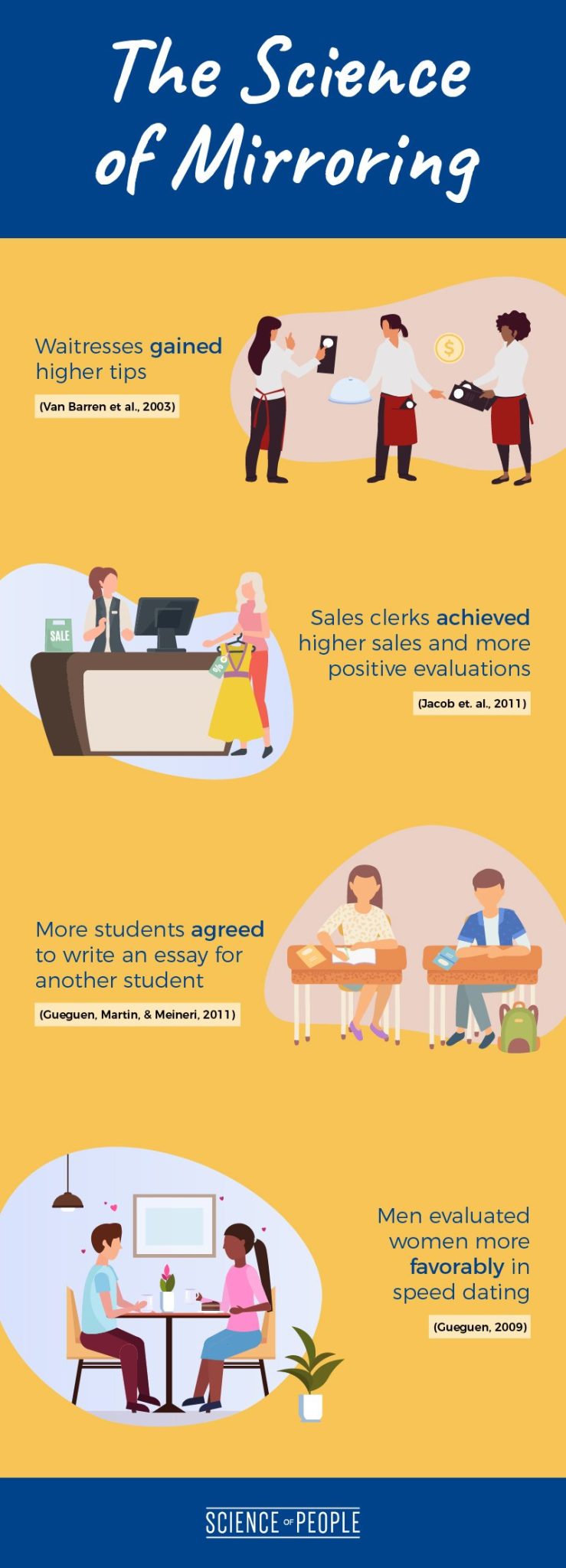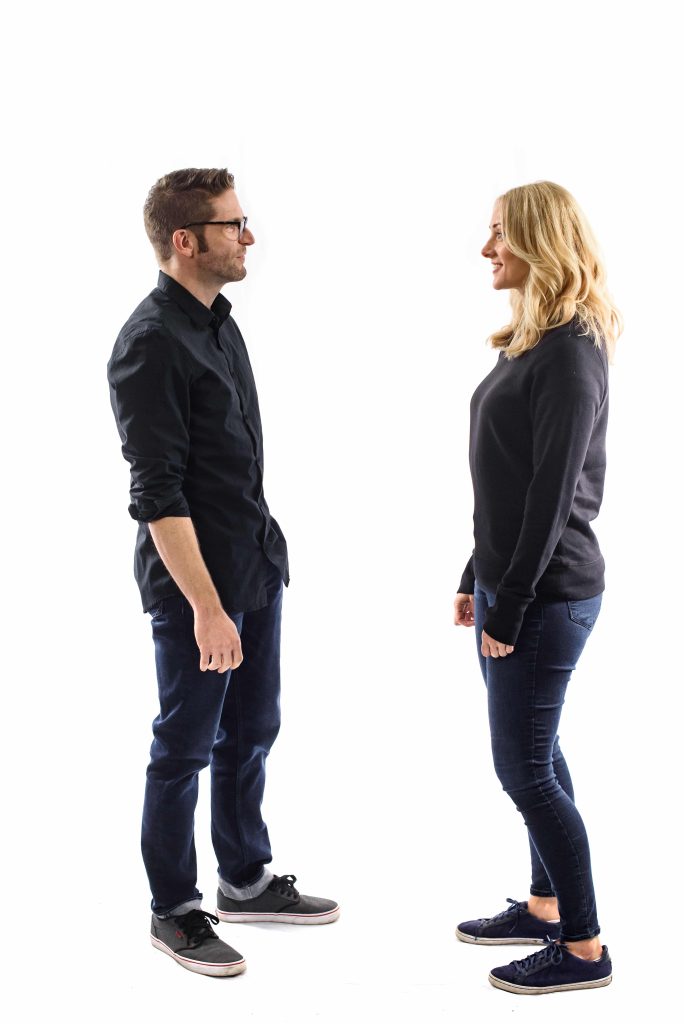This article is part of our body language guide. Click here for more.
Mirroring is a powerful nonverbal way to communicate.
Watch our video below to learn how to read people and decode 7 body language cues:
When done right, research consistently demonstrates its power. Here are just a few examples:

- Waitresses who mirror gain higher tips (Van Baaren et al. 2003).
- Sales clerks who mirror achieve higher sales and more positive evaluations (Jacob et. al. 2011).
- Students agree to write an essay for another student who mirrors (Gueguen, Martin, & Meineri, 2011).
- Men evaluate women who mirror more favorably in speed dating (Gueguen, 2009).
But when done wrong, it’s a disaster, so let’s turn to some science to make sure you get it right every time. But first…

Can You Read Body Language?
How good are your body language skills? Take our free body language quiz to find out!
What is Mirroring? (Definition)
Mirroring, also known as mimicking or Gauchais Reaction, is a nonverbal technique where a person copies the body language, vocal qualities, or attitude of another person. It is usually done subconsciously and can indicate interest or even attraction. Mirroring can occur many times throughout a social interaction and often goes unnoticed.
Monkey Business
Early in the 1990s, researchers at the University of Parma in Italy were doing work with macaque monkeys. Quite by accident, when one of the researchers reached to grab his food, he noticed that the neurons in a nearby research monkey became active as if it were reaching for the food, even though in reality it was sitting idly by.
Startled by this finding, the researchers tested and found they could repeatedly make the monkey’s brain think it was taking action just by watching the researchers. This became the foundation for what are now called “mirror neurons.”
Later, in 2010, Kuhn et al. found that when someone mirrors your behavior, the areas of your brain that activate are the same ones that process rewards and make you feel good. And not only that—urges to mirror others are hardwired in the brain because cooperation leads to more food, better health, and economic growth for communities1.
So not only is mirroring hardwired in your brain, it is also rewarded!
It is this hardwiring that you need to take advantage of to do mirroring the right way.
Mirroring Nonverbally
Before you jump into mirroring, you should lay common rapport-building groundwork first.
In other words, make sure to start with the basics first. Here’s how:

Fronting
To start, you want to give the other person your complete attention. Start by fronting the other person—that is, squaring your body so you are directly facing them.
Fronting is intense; I found it builds much more rapport than standing shoulder-to-shoulder or at an angle. If you’re at a business meeting, try picking the right seat and using your body language to front toward them. If you’re on a date, keep your body pointed at them most of the time. They need to literally be the center of your universe.

Eye Contact
A funny thing about eye contact is too little and you will seem tentative, and too much, you might seem creepy. Go for the middle ground (see tip #1 in this post for more info!).
This not only demonstrates your interest level in the other person through your undivided attention, but, according to Dr. Kerstin Uväs-Moberg in her book The Oxytocin Factor, making eye contact releases oxytocin—this hormone is absolutely critical to create those warm feelings we feel when making a close connection.
Triple Nod
The triple nod does two important things. First, research shows when you do the triple nod, the other person will speak 3 to 4 times longer, making them feel listened to and important1. And second, when you nod, you are basically agreeing with what the other person is saying, and this builds what scientists call a “yes set.”
A yes set is like when a salesperson asks you a couple of simple questions, like Is it still June or It sure is warm today, isn’t it. You say yes—even if only in your mind—and research shows once you start saying yes, the more likely it is you will continue to do so.
Yes sets build connections. So when you nod, you build your own yes set and further strengthen the connection you are making.
These are the main body language cues that I use to mirror. However, from eye gaze to the way we sit and even how we dress, there are so many more mirroring cues to learn.
For a complete list of cues you might want to mirror, check out our body language guide.
Throughout all of this, a lot of mirroring is likely happening naturally on its own, but here are some mirroring techniques you can use now to build and amplify someone’s connection to you.
Mirroring Vocally
Many times, people think of mirroring as mimicking physical actions, but mirroring refers to all the nonverbals. People who are in a groove will actually unconsciously mimic each other’s voices—this is called phonetic convergence. Start with mirroring the pace and volume of the other person’s speech.
Match Their Pace and Volume
If they are a super fast talker and loud, increase your volume and animation. If they are soft, slow, and more relaxed, match them at this level instead. Pace and volume matching is easy to do and much less obvious than physical mimicry.
Want to know a great example of pace and volume matching? Check out Murr from Impractical Jokers. Murr ramps up the excitement, and the potential new roommate actually matches his pace and volume. Watch for the vocal mirroring cues:
Match Cadence
How different do you speak?
Do. You. Speak. Monotonously. Like. This? Or dO yOu SpEAk wiTH voCAL variETY?
Vocal cadence is the way your voice flows. It’s the pauses between your words and how the rhythm sounds. It might help if you think of each person’s voice like a song with its own unique lyrics and melody.
And since research shows that we prefer voices that sound like our own, try mimicking the pauses and flows of a person’s voice.
Along with that, head on over to our vocal body language guide to master the nonverbals of vocals.
Mirroring Verbally
Another neat trick you can do is to mimic a person’s word choice. For example, I love to use the word “fabulous.” It’s leaps and bounds better than “good” or “great,” and it also sparks joy when I use it.
To mirror me, you can also say something like:
- “Fabulous job today!”
- “That movie was so fabulous!”
- “I’m feeling so fabulous!”
The key is to do this subtly. Sprinkle it throughout your conversations like a little bit of cilantro on top of the main dish—and try to avoid overusing it. Sound fabulous?
Identify Their Punctuator
Because you have been carefully paying attention to the person you’re mirroring the entire time, you will have noticed a favorite “punctuator” that the other person uses to make a point. It could be anything like:
- an eyebrow flash (quick raise of the eyebrows)
- some type of hand gesture like politicians often use
- a certain facial expression they make when they’re happy
Here is a story of how I used a punctuator: Earlier this year, when I was having lunch with a physician who was pitching a public, private, and institutional partnership, I noticed that when he was particularly adamant about an issue, he would bring both hands in front of his body and thrust them vigorously up and down. As he spoke, I prompted him on by nodding in pace with his plea, and when he came to his conclusion, I mimicked his double-handed gesture as he made it himself. He stopped, looked at me, cocked his head, and said, “Yes! You understand it completely!” and smiled with a nod.
The thing is, I hadn’t said a single word.
Pro Tip: When it comes to mirroring, do it cautiously. Mimic the other person, but wait a moment or two, and do a similar move but not an exact one. If they pick up on it, you’re busted!
Testing the Connection
This last part is optional, but if you really want to test your connection, make an overt action unrelated to your conversation and see if it is mirrored back.
During the break following a keynote speech I had given, an audience member came up to me and we discussed the similarities that he and I had with our fathers, who had both been in World War II. At one point while he was talking, I had an irritating itch on my nose that I quickly scratched, but then I noticed he reached up and scratched his own nose, all the while continuing on with his story. It seemed so out of place, I decided to test this to see if it was a fluke. A moment later, I scratched my head and he suddenly did exactly the same thing. It was so odd, I almost laughed out loud.
Warning: Do not do repeated testing as this will quickly break the connection!
Mirroring Body Language and Flirting
Does mirroring work for flirting? You bet it does!
One study found that men rated women who mimicked them more positively. Men also are less likely to mirror someone unless they’re seeking a companion, so if you catch him mirroring you, it can be a very good sign.
But the key to mirroring men is to mirror their body, not their face. Since men are naturally less facially expressive than women, men often use more body language cues than facial cues.
Women, however, are slightly different. We mirror other women 4 times more than a man is likely to mirror another man. We are experts at body language, so to win a woman over, you’ll need the full arsenal—mirror her voice, watch her punctuators, and especially use your facial expressions. Research shows when a man mirrors a woman’s facial expression as she talks, she will describe him as caring, intelligent, interesting, and attractive1.
And have you ever heard that phrase, “Love is in the air?” People may use it to refer to that magic we feel when on a romantic date with someone we just “vibe” with. This is no coincidence—these vibes can be from mirroring someone so closely that we feel like we’re in sync with someone else.
On a date, you might notice your potential lover asking what you’re about to order or which seat you prefer. They might do this subconsciously to mirror your actions—“Hey! We wanted to order the same thing!” or “Perfect! Then I’ll sit over here.”
There’s a reason restaurants play fancy music too. It’s designed to get your bodies moving and grooving to the rhythm so you’re both mirroring each other.
But it’s not only about mirroring. Attraction is more than that. Look for other male and female signs of attraction in order to really nail down attraction.
Pro Tip: How to Tell if Someone is Mirroring You
Say you’re at a bar or with a group of friends. You have a hunch but want to really know who’s mirroring you. My favorite trick to see who’s checking you out is to perform a subtle but noticeable move, like checking your watch for the time or crossing your legs. If you notice anyone else doing the same, they might be paying close attention to you and subconsciously mirroring your moves!
Birds of a Feather Flock Together
In 1987, researchers suggested that spouses’ faces generally started looking more similar as time went on. And anecdotally, you might think this is true.
But a 2020 study found that couples’ faces do not actually become more similar over time… although their faces DO tend to be similar.
In a nutshell, this is the Similarity/Attraction Theory in action, which states that 2 people who are similar to each other will like each other more than 2 people who are different.
Mirroring is Everything
Studies of mirroring that use slo-mo film show a “microsynchrony” of small movements so sensitive that it is hard to see with the naked eye2. These movements include tiny momentary dips and nods of the head, tensing fingers, stretching lips, and tiny jerks of the body—all beautifully matched when a pair of friends are in strong rapport.
We might not be able to see subtle mirroring, but the brain still registers it.
So the bottom line is, if you’re thinking about mirroring someone, lean on the side of subtleness rather than overperforming and risking being too obvious.
One final word of caution: When you mirror, make sure that you are mirroring positive nonverbals and nothing negative like turning away, blocking with your arms folded, closing your eyes, or looking away.
So get out there and make those connections, and if we are doing mirroring right, we’re making two reflections into one (and yes, I did just quote Justin Timberlake).
Great, now that song is going to be in my head all day…
Crack The Code on Facial Expressions
The human face is constantly sending signals, and we use it to understand the person’s intentions when we speak to them.
In Decode, we dive deep into these microexpressions to teach you how to instantly pick up on them and understand the meaning behind what is said to you.
Don’t spend another day living in the dark.
This post was co-written by me and Todd A. Fonseca, a twenty-year medical device executive, published author, columnist, international speaker, and Science of People–Certified Body Language Trainer specializing in developing leaders at all levels. You can follow him on Twitter and, along with countless others, take advantage of the free content he offers on his website.
Sources:
- Guéguen, Nicolas. (2009). Mimicry and seduction: An evaluation in a courtship context. Social Influence. 4. 249-255. 10.1080/15534510802628173.
- Pease, A. (2017). The definitive book of body language: How to read others’ attitudes by their gestures. London: Orion.
- Morris, D. (2012). Peoplewatching: The Desmond Morris Guide to Body Language. London: Vintage Digital.
- Tea-makorn, P. P., & Kosinski, M. (2020). Spouses’ faces are similar but do not become more similar with time. Scientific Reports, 10(1). https://doi.org/10.1038/s41598-020-73971-8
- Babel, M., McGuire, G., & King, J. (2014). Towards a More Nuanced View of Vocal Attractiveness. PLoS ONE, 9(2), e88616. https://doi.org/10.1371/journal.pone.0088616
- Anne Bodmer Lutz. (2013). The Yes-Set. American Psychiatric Publishing EBooks. https://doi.org/10.1176/appi.books.9781615370986.al03
Side Note: As much as possible we tried to use academic research or expert opinion for this master body language guide. Occasionally, when we could not find research we include anecdotes that are helpful. As more research comes out on nonverbal behavior we will be sure to add it!

Thanksust wanted to say thanks. Because I was Guilty of this time to time. And I’m sure there’s a lot of people but don’t realize It. But i man To say so. And I love the video and yes I shared
Thanks,Sincerely Steve
Thank you for reading and sharing, Steve!
Danielle | Science of People Team
What I love is that even if someone is not familiar with how mirroring affects their connection with other people, they still do it anyway. The subconsious nature of nonverbals is so fascinating. Before reading this article and having a very basic knowledge on body language, I noticed previously how I would absentmindedly mirror people with whom I felt very connected with, particularly a person of the opposite sex. Now that I know how mirroring has the potential to really enhance a connection and communication with someone, it’s fun to purposely move and orient my body a certain way and see if the other person mirrors my movements. In a recent conversation with a friend of mine, I had tucked up my knees and set my feet on the bench we were sharing while holding a conversation, and almost immediately he mirrored my same posture; when I ran my thumb across my cheek/jawline, he also did the same. Reflecting back to situations at work, I know that I unconsciously match the pitch and volume of my customers when we hold a conversation. I love how applicable, and powerful, that nonverbal mirroring can be in every-day situations!
This is amazing, Lauren! And what a cool social experiment to continue to try out with friends, family and co-workers!
Danielle | Science of People Team
Lauren, great story and insights! Once you start noticing this, it is hard to stop seeing these signals everywhere.
I will trying is techniqu
Narcissist use this tactic to gain control and manipulate their targets I’m not so sure it has the effect that others relate apparently when someone is mirroring you you are not enjoying them or becoming infatuated with them or loving them you are experiencing they’re mirror of you so you are being delighted by the mirror have yourself since finding peace and the kingdom of heaven cannot be found outside yourself it may be being reflected back to you we’re at the Kingdom can be found within you that kind of makes sense
Thank you